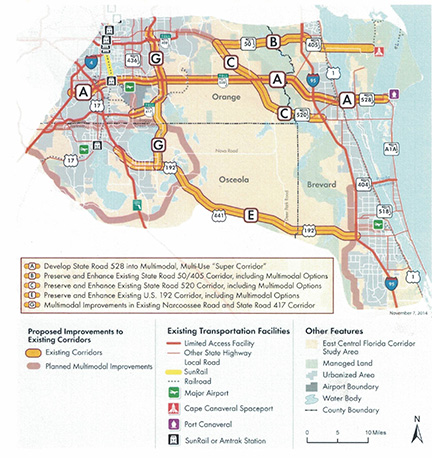By Victoria Parsons
 The fastest route between two points may be a straight line, but a new focus at the Florida Department of Transportation is looking beyond that adage to protect important environmental lands.
The fastest route between two points may be a straight line, but a new focus at the Florida Department of Transportation is looking beyond that adage to protect important environmental lands.
The Future Corridors planning initiative, coming to Tampa Bay later this year, looks at innovative ways to move people and cargo via high-speed high-capacity corridors for the next 50 years, including new corridors that connect key regions of the state. The first segment of the strategy was unveiled late last year for east central Florida, detailing plans for major transit systems to accommodate more than twice as much traffic.
Nine corridors – expanding five existing highways to multi-modal “super-corridors” and four new multi-modal systems – were proposed by a group of stakeholders representing state and local governments, major developers and economic interests as well as environmentalists Charles Pattison, policy director of 1000 Friends of Florida, and Charles Lee, director of advocacy for Audubon Florida.
Conservation and “countryside” topped the list of the task force’s guiding principle, and environmental features were identified before any other considerations. “It was a very positive experience,” said Pattison. “The DOT (Department of Transportation) understood the local comprehensive plans and regional visions and is looking at a 50-year plus timeframe so it wasn’t just an excuse to build another road.”
Work on the Tampa Bay to Jacksonville plan won’t follow the same procedure because the region is so much larger and diverse, but visions developed by local communities – including OneBay in Tampa Bay and First Coast Vision in Jacksonville – will be central to the effort. “We want to drive growth in concert with the long-range visions of these communities,” said Jim Wood, FDOT’s director of policy planning.
The already-crowded I-4 connection to Orlando is also targeted as part of the Future Corridors planning initiative, although it has taken a back seat to the current construction through Orlando. “The interchanges there were planned before Walt Disney started buying land, so we’re looking at some very significant changes there,” Wood said.
For all Future Corridors, multi-modal alternatives will be emphasized, including “super-corridors” that would carry roads, trains and potentially bike traffic as well as electrical transmission lines. The wide corridors might even serve as locations where stormwater can be harvested to supplement water supplies. “The goal is to reduce the overall footprint of development,” he said.

The roads will focus on safety and commerce, particularly providing easy access for trucks leaving the Port of Tampa bound for northern cities. Already the section of Interstate 75 from Wildwood north to Gainesville has crash rates similar to those found in urban areas, Wood said.
Although the task force to be formed later this year will make the ultimate decision on the new connections, Wood envisions the Suncoast Parkway running even further north, probably to State Road 44 near Gainesville. “There’s a very high level of trucks on U.S. 301 and I-75, so another limited-access highway should help relieve that traffic.”
Suncoast Parkway II, which is on the drawing board through Citrus County, will feature wildlife crossing under the parkway and will probably continue the popular bike paths created for the first phase of the highway, he adds.
In addition to moving people and freight, the task force will be charged with protecting rural areas, recognizing that interchanges spur growth. “We will be very conscious of where interchanges are built,” Wood said.
So far, residents have “seen more benefits than concerns” for the preliminary plans, he added.
Funding for the construction is still to be determined, with federal dollars limited and revenues from the state gas tax dropping as cars become more fuel-efficient.
Funding issues also raise flags for Pattison, who is concerned that landowners who can provide land for road construction will carry more weight in the planning process. “The reality is that there is not a lot of money lying around for roads,” he said.
Still, he’s optimistic about a strategy that looks at environmental needs first, and then takes a regional approach rather than a county-by-county plan. “They’re saying all the right things but the real issue will be follow-through.”
For more information, visit dot.state.fl.us/planning/policy/corridors/ or http://ecfcorridortaskforce.org/doc/ECFCTF_SummaryReport_signed.pdf